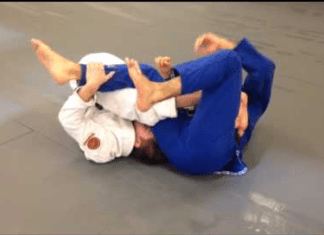
The art of Jiu-Jitsu has existed throughout the world for hundreds of years. With its roots in feudal Japan, jiu-jitsu (“jujitsu”, then) was used on the battlefield for close combat, in situations where weapons were ineffective. Centuries later Japanese Jiu-Jitsu was introduced to the Gracie family in Brazil, around the year 1914, by Esai Maeda ( also known as Conde Koma).
Helio Gracie took the traditional Japanese Jiu-Jitsu techniques taught by Koma and modified them to be more effective against larger, stronger opponents–as Helio himself was typically not the largest or strongest person in the gym.
The Gracies began challenging other martial artists throughout Brazil–and eventually, the world–to prove the effectiveness of the newly-fledged Gracie Brazilian Jiu-Jitsu. They accumulated countless victories over other fighters through their Vale Tudo (“anything goes”) matches. Helio fought dozens of times, including legendary matches with Yukio Kato, Wladek Zbyszko, and Masahiko Kimura. Despite being outweighed by nearly 36 kilos by Kimura–not to mention that Kimura was one of the most dangerous Judoka alive–Gracie held his own for 13 minutes, and had his arm broken (hence the origin of the “Kimura” arm lock) yet didn’t tap out… his brother Carlos Gracie had to throw in the towel. Even though Gracie lost the match, he proved to the world that Brazilian Jiu-Jitsu was a force to be reckoned with in the realm of combat sports. It has skyrocketed in popularity ever since.

We could go into the importance of each key grappler throughout the last hundred years or so (Gracie, Garcia, Bravo, Lister, etc), but the trend has always remained the same: constant evolution and honing/diversifying techniques, but with a relatively limited range of focus, due to geographic location and lineage. Compare traditional Japanese Jiu-Jitsu to Brazilian Jiu-Jitsu, and they are quite different… compare traditional BJJ to modern no-gi jiu-jitsu, and the differences are even more pronounced. This occurred because the world was so large, and unifying “styles” of jiu-jitsu worldwide was nearly impossible at the time. Then, at the end of the 20th century… the Internet hit the world. Suddenly all forms of artistic medium became readily available–music, films, photos, literature, memes and… MARTIAL ARTS. Jiu-jitsu would never be the same again.
I have been fortunate enough to train jiu-jitsu in the U.S., Japan, South Korea, and Argentina over the last few years, and it simply amazes me how all of these countries have their own definitive style of jiu-jitsu; different training methods, different drills, different philosophies regarding how they train jiu-jitsu! The Gracie Jitsu Jitsu gym in Ushuaia, Argentina was certainly much different than the 10th Planet gym I train at in Woodbury, Minnesota. It’s overwhelming to consider how many different forms and styles there are worldwide of BJJ alone–let alone every martial art in existence.
After training in jiu-jitsu and eventually becoming addicted to the sport–as I’m sure we all have–I inevitably fell down my first serious Internet Jiu Jitsu Wormhole. I decided to filter the politics and memes and adorable kittens that I looked at daily on my social media feed and replace it all with jiu-jitsu, wrestling, MMA, boxing, et cetera. Video tutorials, articles, theory, competitions, fights… I learned that there is a virtually infinite amount of knowledge out there on the art that we are obsessed with. I discovered that jiu-jitsu is evolving right now, as we speak. I heard guys at our 10th Planet gym in Woodbury talking about the Danaher Death Squad… then in Tokyo, Japan I heard the same names: Garry Tonon, Gordon Ryan, Eddie Cummings, and so on. This led me to the major realization that because of the Internet, and due to the dedication of grapplers worldwide, our sport is now interconnected in ways that we couldn’t imagine just a few short decades ago.
The age of newspaper and telegram is long behind us; now when there’s an international competition, every dedicated jiu-jitsu player on the planet knows about it. Through ADCC, Metamoris, EBI, F2W, the UFC, and countless others, we get to see the world’s best fighters, fighting other elite fighters. When Craig Jones came out of Australia and started doing heel-hooks from Z Guard on high-ranked opponents, grapplers worldwide started looking up Z-Guard techniques and trying to throw them into their game.
Even if you don’t have time to train as often as you’d like, you can use the wealth of online knowledge to still evolve your game–or at least, your understanding of jiu-jitsu. You can learn different setups for armbars or a good defense for the straight ankle lock, and to apply it next time you roll. This was completely not possible even a few decades ago! Back then, You would have to just be fortunate enough to train with highly-skilled instructors, constantly running the risk of dedicating your time to a “3rd-degree black belt,” in a martial art form some weird guy with a mullet just made up. Now you might still end up training with that Mullet-Sifu, but at least you can make an educated decision about whether you continue to train there.

Martial arts have evolved so rapidly over the centuries, but now we are looking towards a future of combat sports that is simply unfathomable. It is truly amazing to watch such a beautiful sport evolve in front of us–but it’s even more amazing to watch that calf-slicer tutorial 30 times at two in the morning… then go hit it in your next roll. Here’s to the past, and to the future… now go train!
Guest Post Written By:
– Matthias Joyce, blue belt Valhalla Combat Sports – Fridley, MN Next Level Combat – Woodbury, MN
The Difference Between Japanese (traditional) Jiu-Jitsu And BJJ
Helio Vs. Carlos Gracie – Gracie Jiu-Jitsu History And Politics
MMA History – Gene Lebell VS Milo Savage, 1963 – First Televised MMA Fight ever!











































